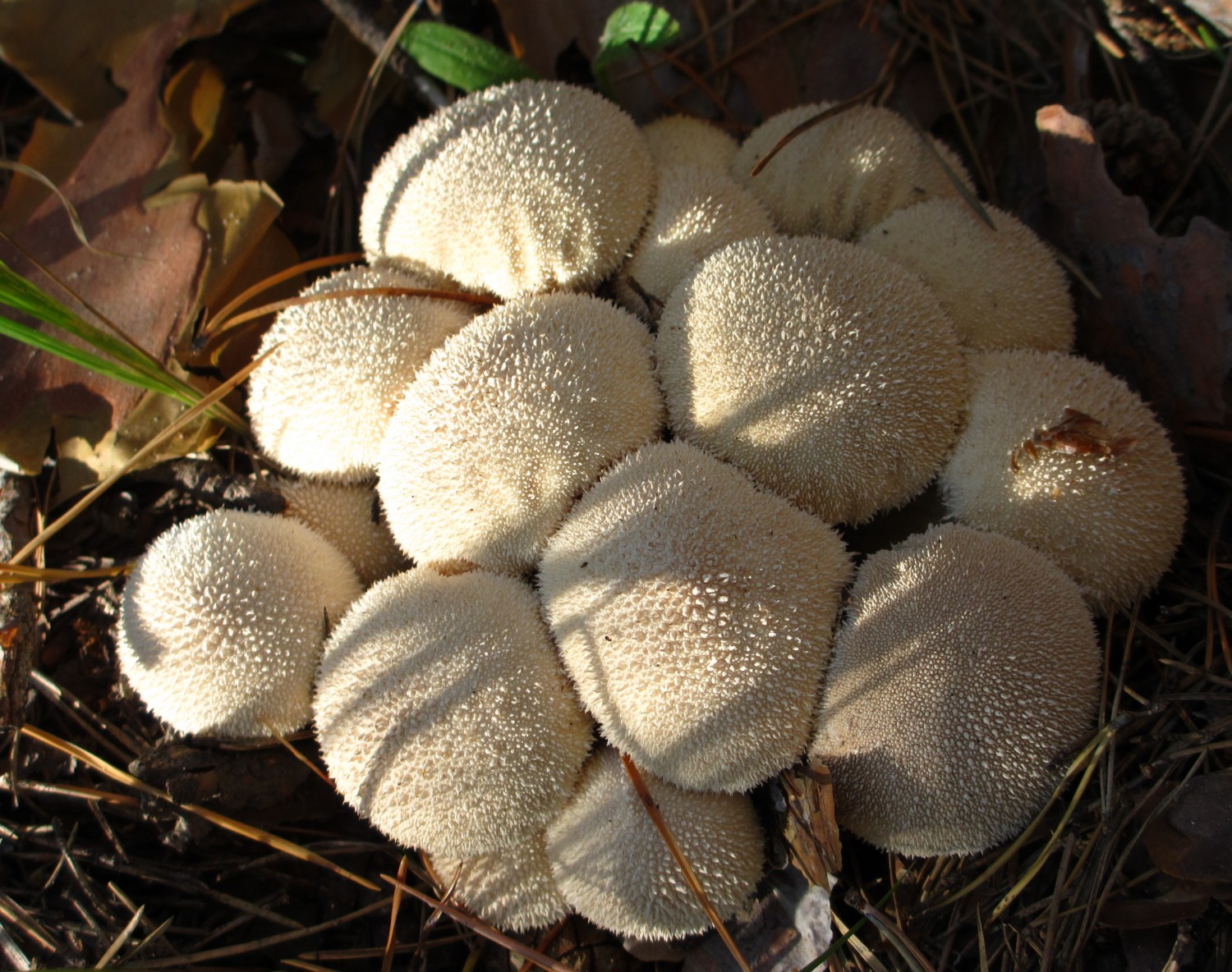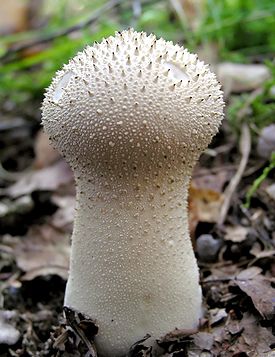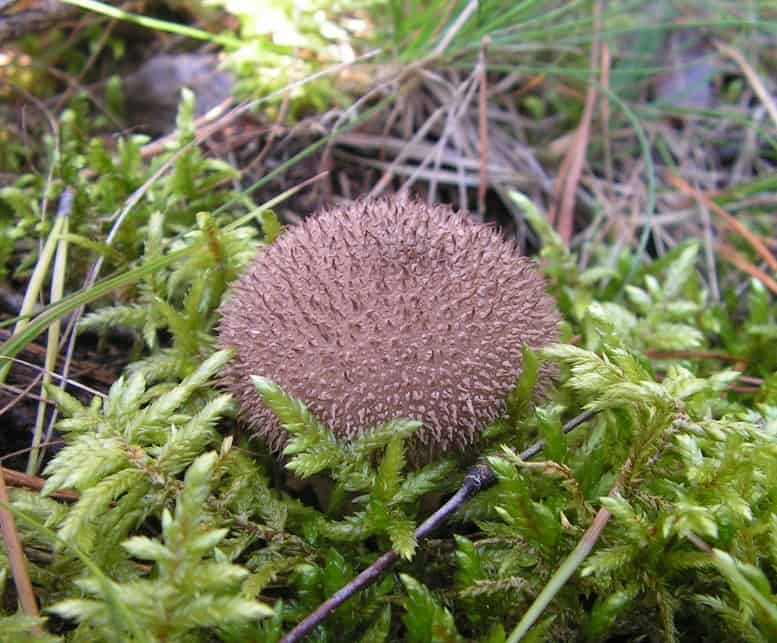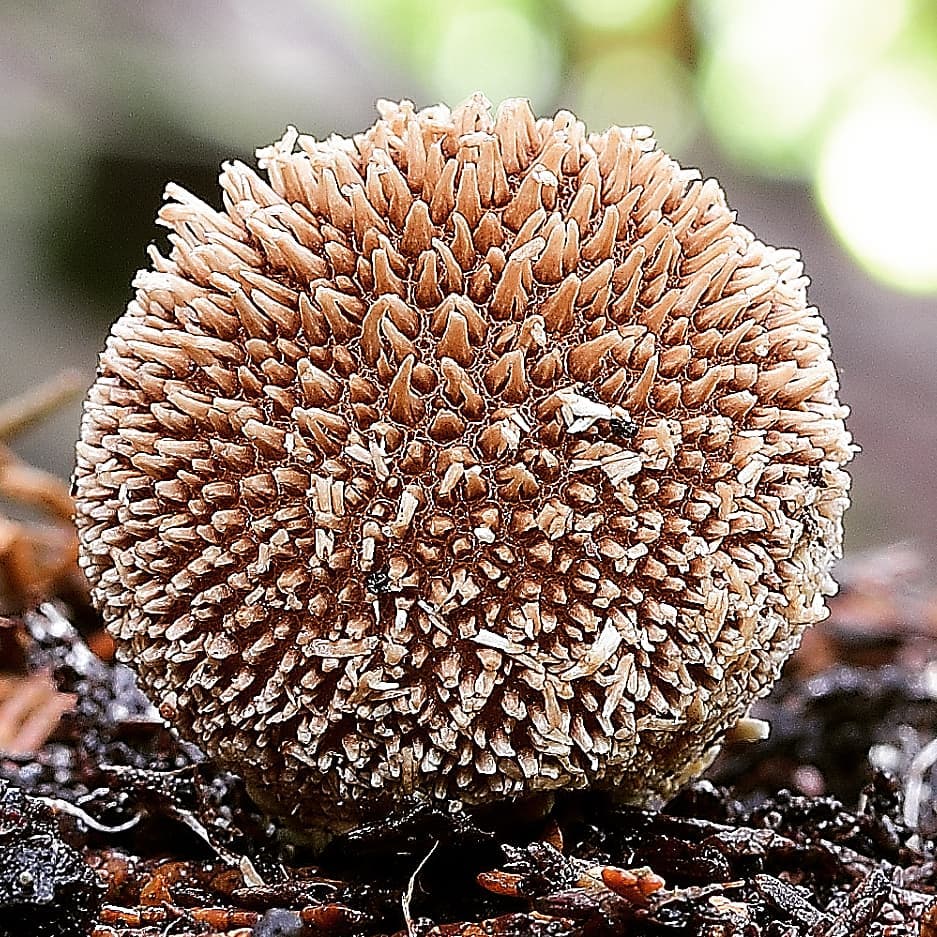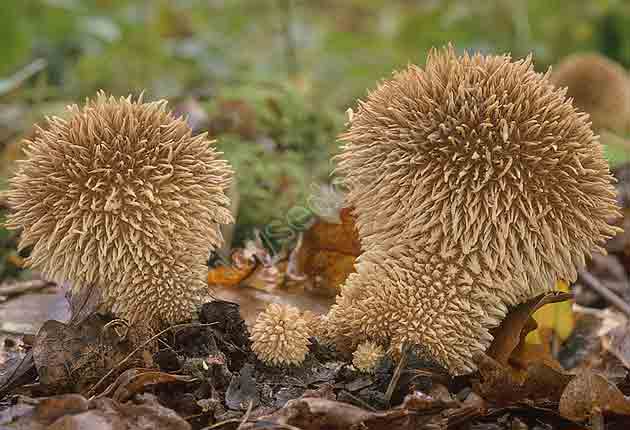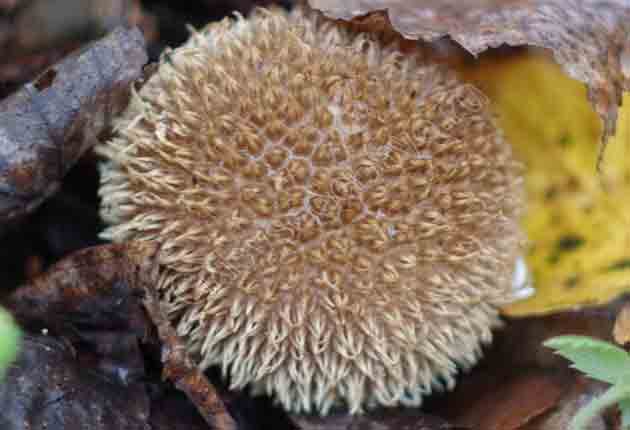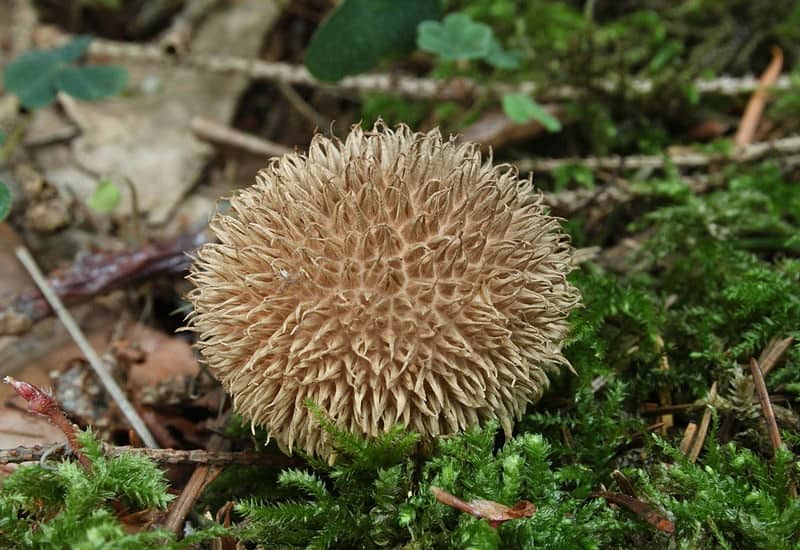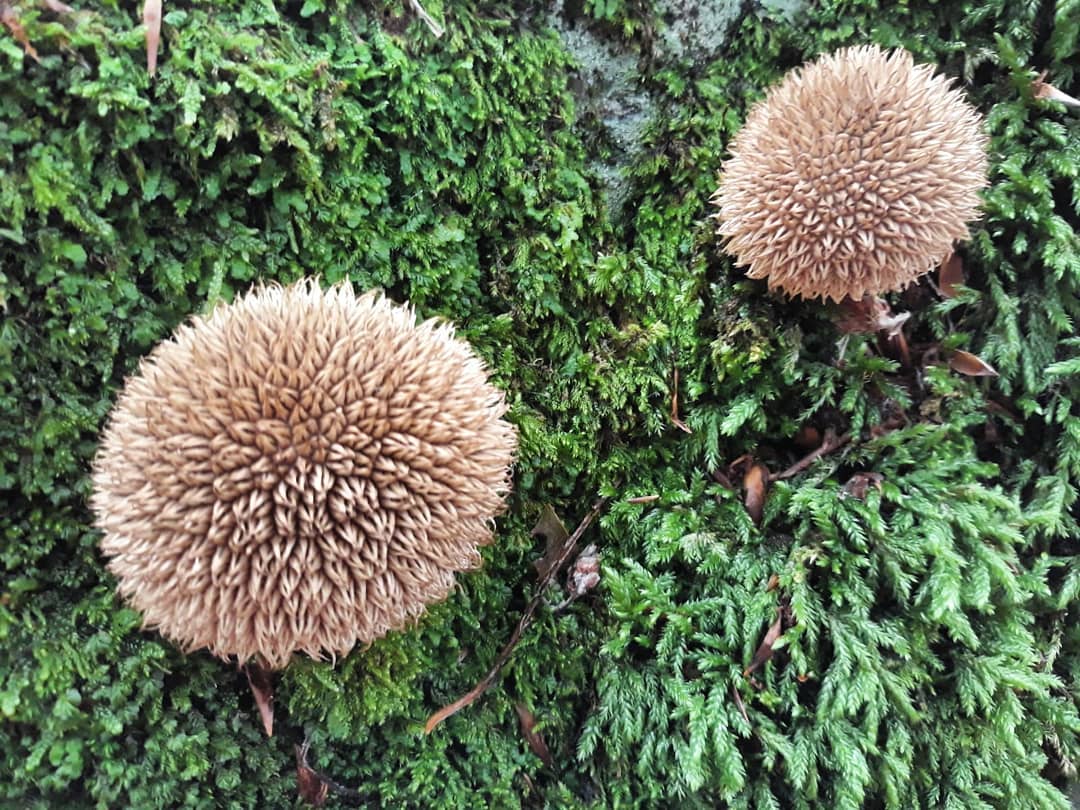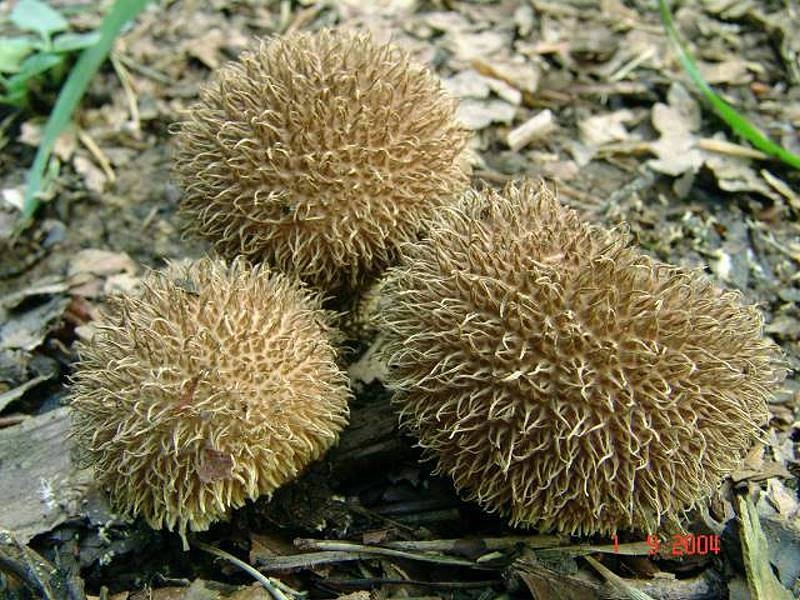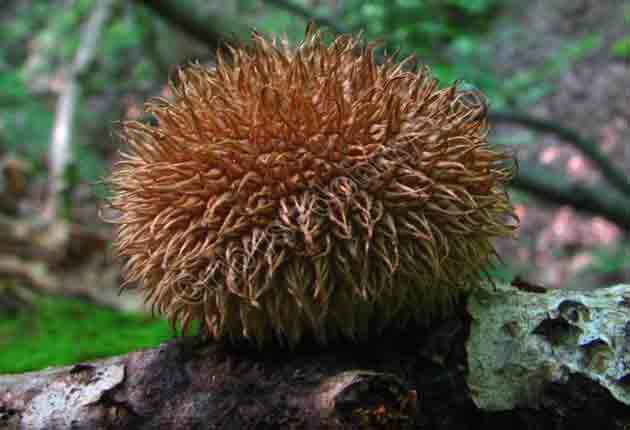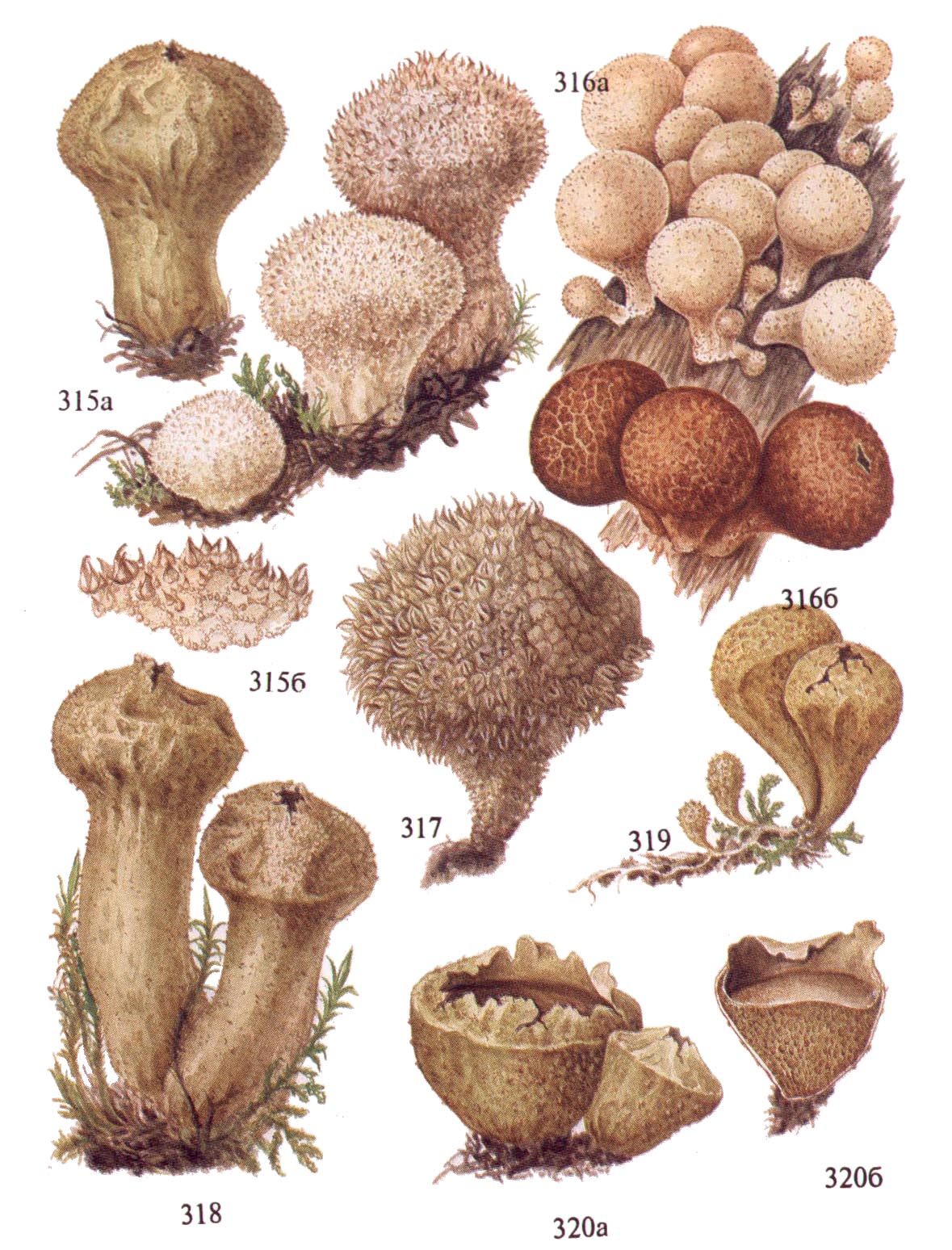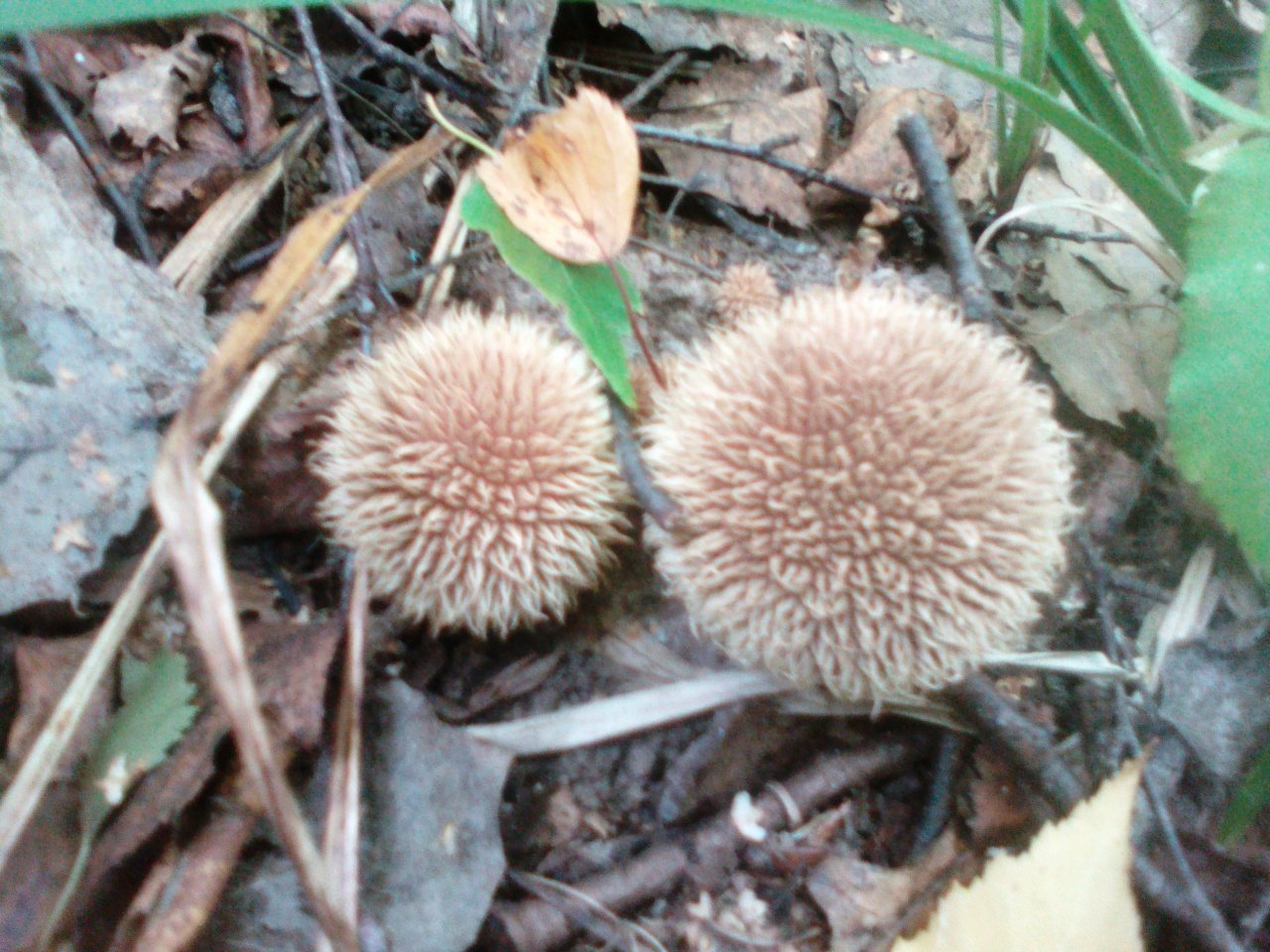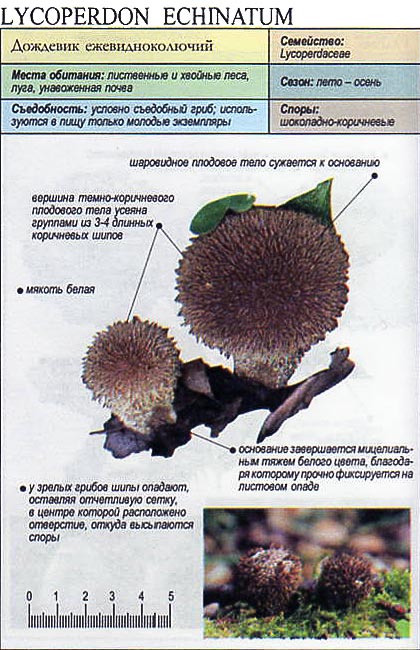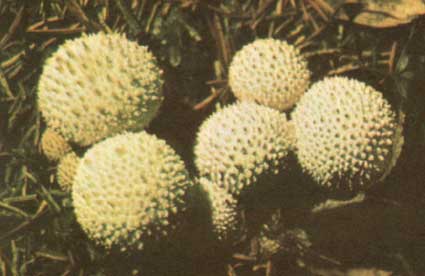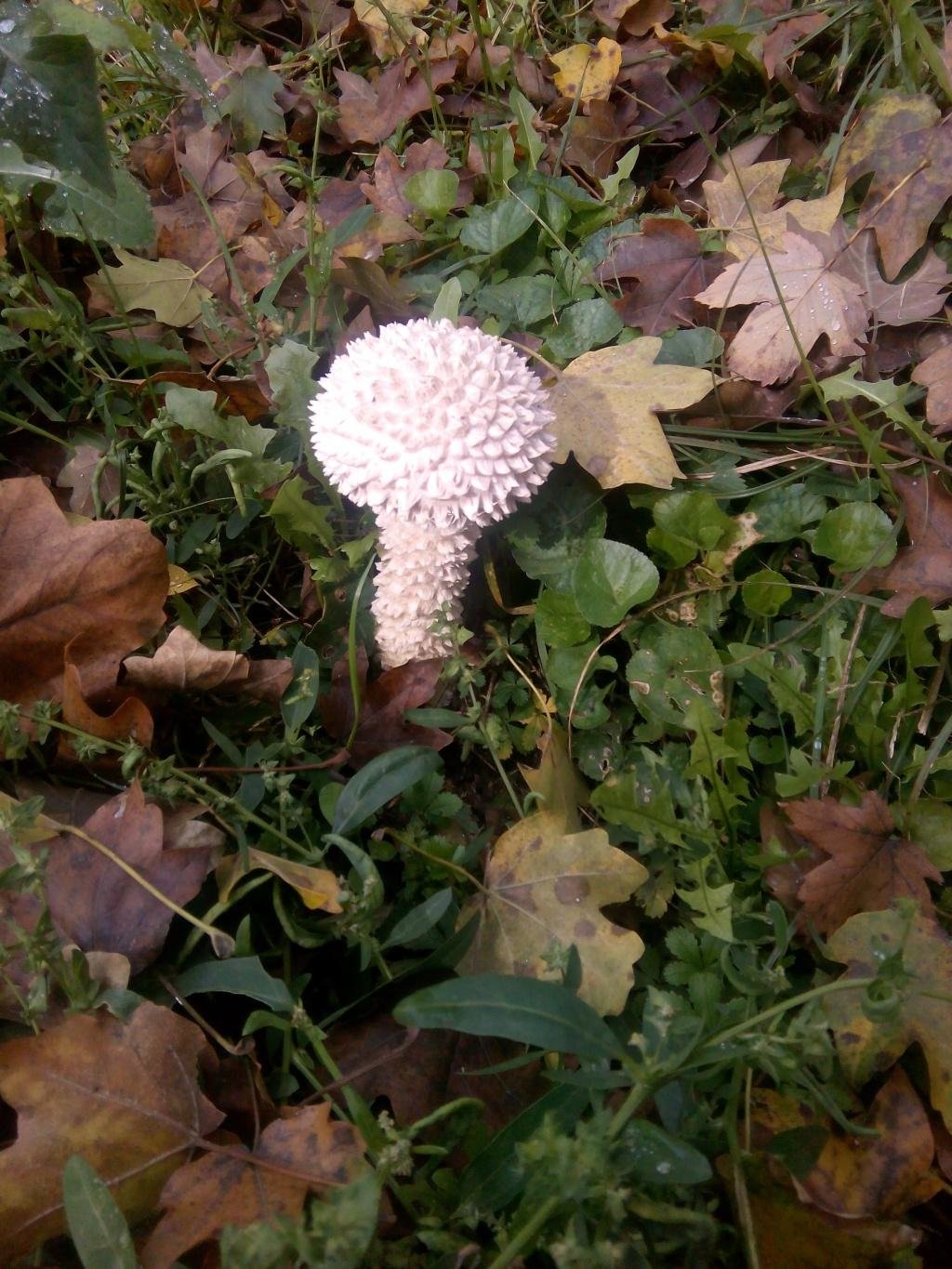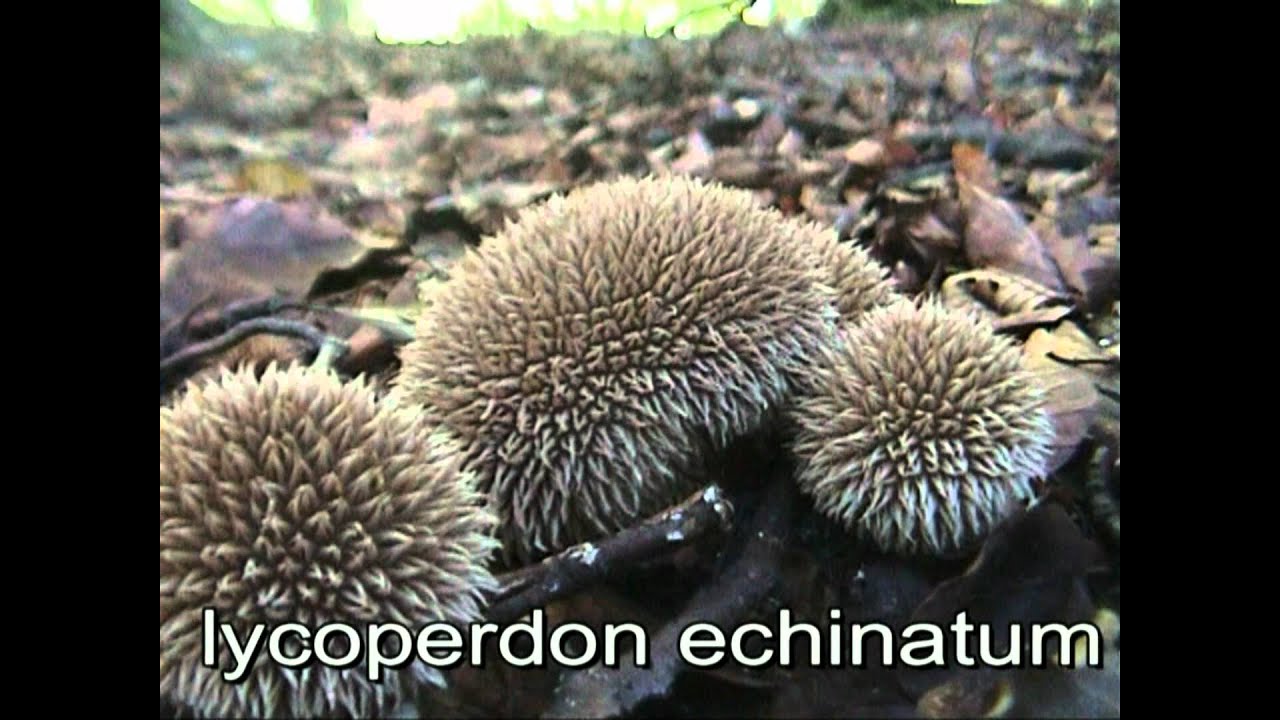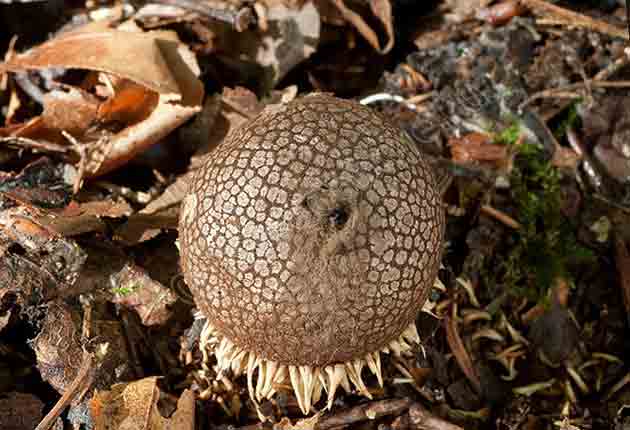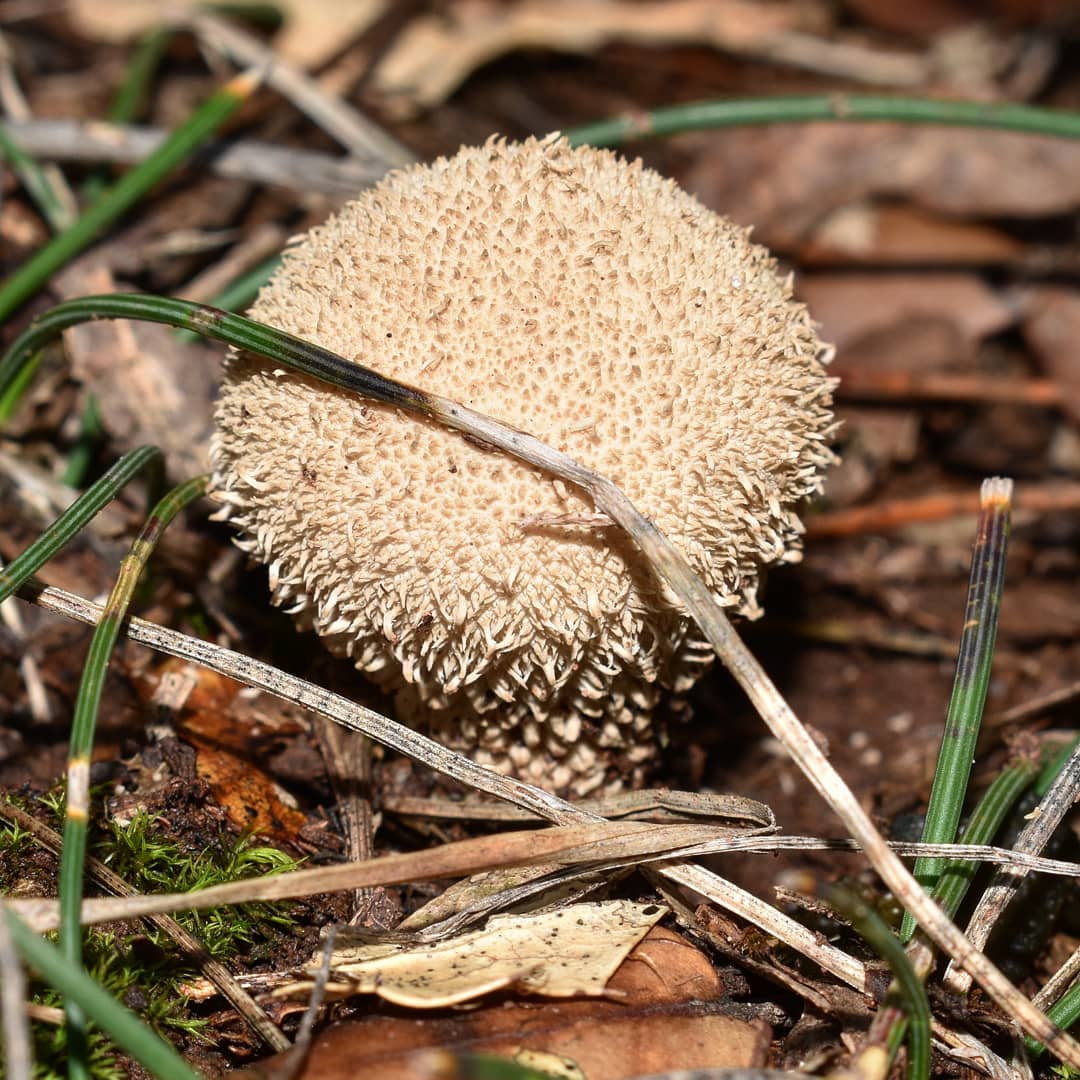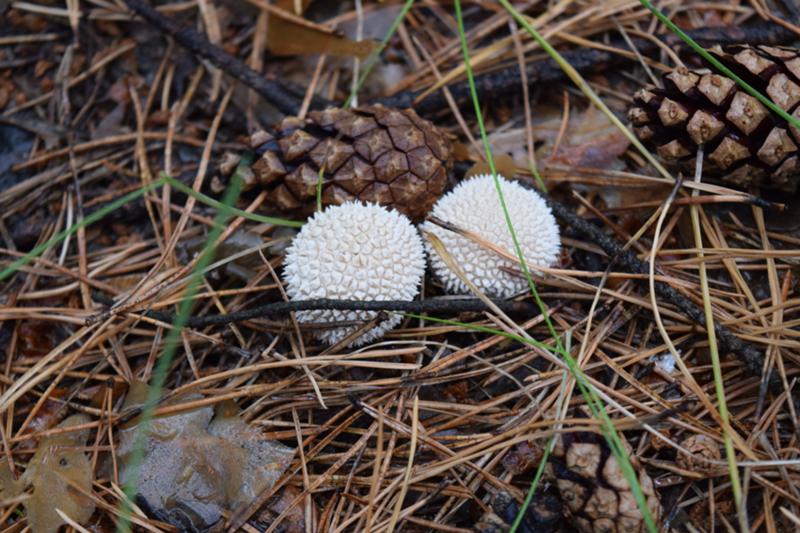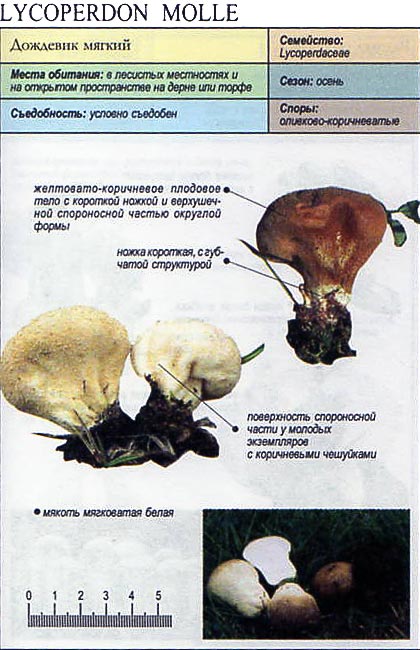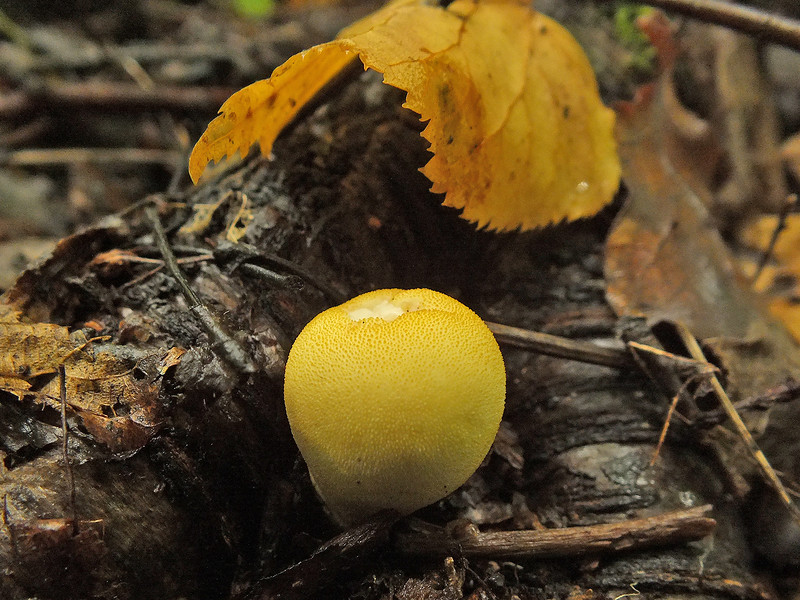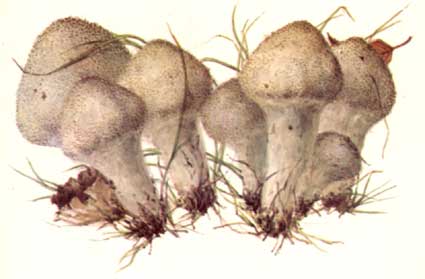Recipes for making edible raincoats at home
Edible raincoats are considered dietary products. 100 g of mushrooms accounts for about 4.3 g of protein, 1 g of fat, 0.8 g of carbohydrates and no more than 27 calories. You can eat them in boiled, fried, baked, stewed, salted or pickled form. Freshly harvested, frozen or dried raincoats can be used as raw materials.
Cleaning
Rubbing or trying to cut off the skin with a knife is not worth it, as the mushroom will crumble due to the fragile texture. It is better to first soak the raincoats in water for a couple of minutes, and then gently wipe their surface with your fingertips. Large mushrooms should be removed from the skin - pry it off with your fingernail and gently tear off the pulp.
Cooking
Raincoats are dipped in boiling water and boiled for 25-30 minutes. Water should be taken at the rate of 3 liters for every half a kilogram of mushrooms. Salt and pepper to taste. The resulting broth can be used as a basis for mushroom soup by adding potatoes, herbs and fried onions and carrots to it.
Pickling
For a simple pickle, take 1 kg of peeled and cut raincoats into uniform pieces, cook them for 20 minutes. Then add 3 pinches of salt to the pan, 1 tbsp. l. sugar, 6 black peppercorns, 2 dry cloves stars, 2 tsp. dill seeds and 2 large cloves of garlic. Leave the resulting mixture to boil for 10 minutes. At the very end, add 4 tablespoons of 6% vinegar. The next step is to pour everything over the jars and close the lids. Store pickled mushrooms in the refrigerator or basement.
Freezing
Before freezing, it is recommended to blanch the mushrooms first. To do this, pour water into a saucepan at the rate of 5 liters per kilogram of raincoats. As soon as the water boils, pour the mushrooms and let cook for 5-7 minutes. Then we filter, fill with cold water and pass through a colander again. We pack chilled raincoats in containers (containers, bags) and put them in the freezer. They can be stored frozen for up to 8 months.
Frying
Mushrooms can be pre-boiled in salted water for 3 minutes (so they will be softer). After the raincoats are sent to a preheated pan and fried in oil for 7-10 minutes, at the very end they are salted and pepper to taste. Cooked mushrooms can be used as an independent side dish, mixed with sour cream and onions, or can be added to boiled or fried potatoes.
Salting
Raincoats are salted in a cold way with preliminary soaking (for this you need to hold the mushrooms in cold water for 1-2 hours). After the raincoats are filtered and laid out in a container. Each layer is sprinkled with salt and horseradish, oak and currant leaves, allspice, bay leaves are added. You need about 40 g of salt for every kilogram of mushrooms. A lid or a plate of a suitable size is placed on the container and pressed down with oppression (weight). Cold pickled mushrooms will be ready for testing in 3-4 weeks. Store them in a cool, dark place.
Drying
The peeled mushrooms must be cut. Do not grind too much, as the slices will decrease in size by 3-4 times during drying. We line the baking sheet with parchment and put raincoats on top. We put the mushrooms in an oven preheated to 50-60 degrees. Make sure that the oven does not get too hot (we need dried, not baked mushrooms), keep the door slightly ajar. When the raincoats are completely dry, they will turn golden brown.
Canning for the winter
We clean the mushrooms, cut them into medium-sized slices. Soak them for 20 minutes in a solution of lemon juice with a pinch of salt - this will prevent the raincoats from turning black when stored in a jar. Then we wash the mushrooms and put them in a saucepan with cold water (5 liters for each kilogram of mushrooms). Cook for 20 minutes.
Now we are preparing the marinade for conservation.In a liter of water, mix the ingredients - 3 branches of thyme, tsp. mustard, Art. l. salt, 2 tsp. sugar, 3 black peppercorns, 2 cloves of garlic. Boil for 7 minutes, then add 100 ml of wine vinegar and keep on fire for another 3 minutes. We spread the mushrooms in jars and pour the broth with spices so that the liquid covers the raincoats by 2-3 cm. We roll up the lids and put them in a cool dark place.
Inedible species
There are no poisonous mushrooms in the Lycoperdon family. But there are unsuitable for food (bitter and difficult to digest). Deadly are false raincoats, which look like raincoats, but belong to a different family (Scleroderma mushrooms).
Warty raincoat (Scleroderma verrucosum)
A small mushroom with a fruiting body 3-5 cm in diameter, wide at the top and narrow at the bottom. There is no pronounced leg (it has a length of no more than 0.6 cm and is completely hidden in the soil). The surface is white-brown. The pulp is white with yellow longitudinal veins. The smell is pungent and rather unpleasant. The mushroom is cosmopolitan - that is, it is ubiquitous. In Russia, it is most often found in oak forests in the Central and Central Black Earth region.
Common pseudo-raincoat (Scleroderma citrinum)
The fruit body is up to 7 cm in diameter. The surface is white with brown spots. The pulp in young mushrooms is yellowish, in mature ones it is gray or purple with large white fibers. Has a smell similar to rotting potatoes. You can meet in deciduous and coniferous forests, on clay and loamy soil. In Russia, it grows most in the European part, Western Siberia.
Spotted raincoat (Scleroderma areolatum)
A pear-shaped mushroom of yellow color with brown spots. The surface is rough to the touch. When cut, coarse greenish pulp with white veins is visible. Mature mushrooms crack when pressed, but spores, like true raincoats, do not generate dust. It grows on soil in moist coniferous and deciduous forests, mainly settles on rotting stumps. Most often found in Central Russia, Eastern Europe and North America.
Bulbous raincoat (Scleroderma cepa)
It has a cone-shaped fruit body of dark yellow or brown color with minor spots on the surface. The base is narrowed and gathered in small folds. The pulp in young mushrooms is white, in mature it is a gray or black mass. Grows in small groups on moist soil, under deciduous and coniferous trees and shrubs. Mostly these fungi are found in deciduous forests, but can appear in gardens, parks, along roadsides.
Star-shaped raincoat (Scleroderma polyrhizum)
A round mushroom with a diameter of up to 15 cm. A young pseudo-raincoat has a spherical shape with a narrowed end. The surface is yellow with white fluff. When ripe, it darkens and opens with petals, revealing a dark brown cavity with a black mass of round spores. Grows throughout Eurasia and North America in warm and humid conditions. It grows in groups of 3-7 mushrooms in deciduous and coniferous forests, on sandy and clayey soil.
Enteridium raincoat (Enteridium lycoperdon)
Distributed in Central Russia. Usually grows on dry tree branches (especially like alder and elms), along the banks of rivers, streams and swamps. Has a rounded or irregular shape. At a young age, white with a crystal-like surface. During the ripening period, the spores are darker, and from above it is covered with a whitish fluff resembling mold. The section shows light flesh with large veins. The smell is rather unpleasant, reminiscent of rotten potatoes.
Smelly raincoat (Lycoperdon montanum)
A yellow or brown mushroom with a wide fruiting body, tapering at the bottom. The top is covered with pointed spines, which, when pressed, easily fall to the ground. The height of the mushroom is up to 5 cm. The diameter in the widest part is up to 3 cm. When cut, it exudes an unpleasant odor similar to gas. The pulp is yellow; when the mushroom ripens, it darkens and is replaced by brown spores.It is found throughout Eastern Europe and in Central Russia in coniferous and mixed forests.
Black and prickly raincoat (hedgehog): photo and description
| Name: | Raincoat black-prickly |
| Latin name: | Lycoperdon echinatum |
| Type of: | Edible |
| Synonyms: | Hedgehog raincoat, Black raincoat, Needle raincoat, Spiky raincoat |
| Specifications: |
|
| Systematics: |
|
The puffball is black-prickly, needle-like, thorny, hedgehog - these are the names of the same mushroom, which is a representative of the Champignon family. In appearance, it can be confused with a small shaggy bump or hedgehog. The official name is Lycoperdon echinatum.
What a black-prickly raincoat looks like
He, like many of his relatives, has a back-pear-shaped fruiting body, which tapers at the base and forms a kind of short stump. The surface of young specimens is light, but becomes light brown as they mature.
The diameter of the upper part reaches 5 cm. It is completely covered with bent spikes-needles 5 mm long, which are arranged in rings. Initially, the growths are creamy and then darken and turn brown. During the ripening period, the thorns slide off, exposing the surface and leaving a mesh pattern. At the same time, a hole is formed in the upper part through which the mushroom releases ripe spores.
The thorns of the black-prickly raincoat are arranged in rings, in the center is the longest, and around the short
The pulp is initially white in color, but when ripe, it turns purple or brownish-purple.
At the base of the fungus, you can see a white mycelial cord, thanks to which it is firmly held on the soil surface.
Spherical spores with characteristic spines on the surface. Their size is 4-6 microns. The spore powder is initially creamy in color, and when ripe changes to a purplish brown.
Where and how it grows
This mushroom is classified as rare. The fruiting season begins in July and lasts until the end of October if conditions are favorable. Grows singly or in small groups. It is found in deciduous forests, as well as in heather wastelands in highlands.
Prefers calcareous soil. Distributed in Europe, Africa, Central and North America.
Is the mushroom edible or not
The spiny-thorny puffball is edible as long as its flesh is white. Therefore, it is recommended to collect especially young mushrooms. In terms of nutritional value, they belong to the fourth category.
Before use, it must be boiled or dried. The black-thorny raincoat does not tolerate long-distance transportation, so it should not be assembled if you are planning a long walk through the forest.
Doubles and their differences
In appearance and description, the black-prickly raincoat is in many ways similar to its other relatives. Therefore, in order to identify twins, you need to know their characteristic differences.
- The raincoat is ragged. The surface of the fruiting body is covered with cotton-like white flakes. The main color is light cream or ocher. Considered edible. Grows in the southern regions, found in oak and hornbeam forests. The official name is Lycoperdon mammiforme.
The ragged raincoat is considered one of the most beautiful representatives of the Champignon family.
A smelly raincoat should not be eaten even at an early age, when the pulp is white
Conclusion
The black-thorny raincoat has an unusual appearance, due to which it is difficult to confuse it with other relatives. But if in doubt, break the pulp. It should have a pleasant aroma and a dense white texture.When collecting, it should be borne in mind that this species cannot be worn for a long time in a basket.
False doubles
Most raincoats are edible, but some are inedible. These include Black and Brown, but they are extremely rare. The main difference between the Meadow Raincoat and its twins is that it has a partition that separates the glebe and the sterile leg.
 Raincoat black-prickly
Raincoat black-prickly
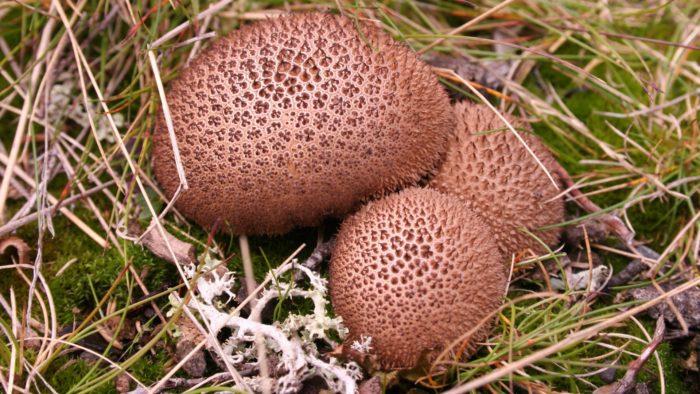 Raincoat Brown
Raincoat Brown
In the photo you can see the difference between the meadow raincoat and its counterparts, which have dark thorns and scales, and they also have yellow flesh.
Separately, it should be noted the Giant Raincoat, which is often considered a mutant. Outwardly, it looks like an ordinary raincoat mushroom, but its dimensions are many times larger than the size of a normal mushroom. It is so big that it can weigh up to ten kilograms. The pulp of this specimen resembles marshmallow or marshmallow in terms of density. The giant raincoat is dangerous, if stepped on, it will throw out a lot of spores, the entry of which into the lungs of a person can lead to death.
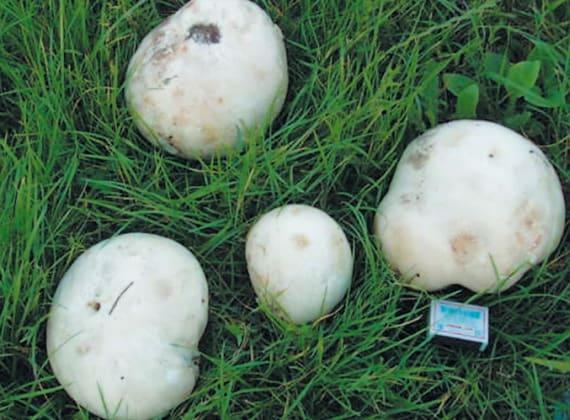 Giant raincoat
Giant raincoat
[edit] Similar views
The real raincoat has similarities with some other members of the genus. Lycoperdon nigrescens has long dark thorns, gathered in groups, similar to the thorns of the Black-thorny Raincoat (Lycoperdon echinatum). The pear-shaped raincoat (Lycoperdon pyriforme) the thorns are less pronounced, and it grows on rotting wood, although it can be found underground, in connection with which this fungus seems to grow on the surface. Lycoperdon peckii differs in lavender thorns at a young age.
Raincoats can be confused with immature fly agarics, in particular, with pale toadstool (Amanita phalloides), stinking fly agaric (Amanita virosa) and spring fly agaric (Amanita verna).
Common pseudo-raincoat
| Group: | Marsupials |
|---|---|
| Plates: | Absent |
| Colour: | Yellowish, brownish |
| Info: | Looks like a potato |
| Department: | Basidiomycota (Basidiomycetes) |
|---|---|
| Subdivision: | Agaricomycotina (Agaricomycetes) |
| Class: | Agaricomycetes (Agaricomycetes) |
| Subclass: | Agaricomycetidae |
| Order: | Boletales |
| Family: | Sclerodermataceae |
| Genus: | Scleroderma (False Raincoat) |
| View: | Scleroderma citrinum (False raincoat) |
Inedible, mildly toxic in large quantities, causes gastrointestinal upset. An allergic reaction to spores in the form of conjunctivitis, rhinitis, etc. is also possible. However, at a young age, it is sometimes added to food in small quantities, since the taste and smell is somewhat reminiscent of truffles. However, the mushroom is not recommended for use.
Description
The common pseudo-raincoat is more like not a mushroom, but a potato. It has no legs and is attached directly to the ground using mycelium strands. The fruiting body of the common pseudo-raincoat consists of peridium (outer shell) and gleb (inner contents). The pseudo-raincoat itself is small in size, reaching only 6 cm in diameter, the shape of the fruiting body is rounded.
Peridium
The surface of the peridium is smooth or with small scales. The color of the peridium is yellowish or brownish. With age, the upper surface cracks with the formation of small "craters", from a distance resembling warts.
The lower part of the mushroom does not crack, it has a wrinkled surface and tapers slightly towards the ground. A mycelial cord departs from it into the ground.
Peridium in common pseudo-raincoat is relatively thick (up to 0.4 cm). In an overripe fungus, the upper part of the shell ruptures with the release of spore powder into the external environment.
Gleb
Gleb, or the inner part of the pseudo-raincoat, is white in young specimens. Ripening, it becomes almost black with a purple tint with white veins. Overripe gleba becomes greenish brown (brown). The smell of the inside of the mushroom is similar to the smell of raw potatoes.
Spore powder
The spore powder of the common pseudo-raincoat is formed from overripe and dried gleb and has a dark greenish-brown color. The spores in it are large, round, with a mesh surface and with thorns. Individual spores are dark brown in color.
Spreading
Common false raincoat is the most common and widespread of all false raincoats. It grows in Russia (the European part, the North Caucasus and the Far East).
It is a saprotroph and grows on rotten trees and humus-rich soil. The fungus prefers light forests, moorlands, roadsides and clearings. Can grow in moss and sand, singly and in groups. A parasitic flyworm often grows on it.
Similar species
A false raincoat is similar to real raincoats, but differs in that it does not have a false leg.
He also has "doubles" among other false raincoats:
Bulbous pseudo-raincoat
Poisonous (weakly poisonous) mushroom, differs from the ordinary false raincoat not by the warty, but by the nipple-like peridium.
Large-root pseudo-raincoat
It has a pronounced and rather long false stem, it grows only in the sand.
Warty and mastoid pseudo-raincoats
They are smaller, scaly peridium and long pseudopods.
All varieties of false raincoats are inedible. Of these, in Russia, the bulbous, warty and the common pseudo-raincoat itself are most often found.
Edibility
Most sources indicate that the common pseudo-raincoat, like the rest of this genus, is inedible and even slightly poisonous. There is a known method of eating young pseudo-raincoats (they taste like a truffle).
Interesting Facts
When eating this mushroom in large quantities (2 - 3 pieces of a young specimen are considered a safe amount), poisoning may occur. It is manifested by pain in the epigastric region, vomiting and nausea, weakness, visual disturbances and loss of sensitivity in the legs.
If such symptoms occur after using the pseudo-raincoat, it is necessary to drink plenty of water and provoke vomiting. You also need to immediately call for medical help. Due to the risk of poisoning, it is not recommended to collect and eat false raincoats.
[edit] Description
The fruiting body is 3-8 cm in height and 1-5 cm in width, pear-shaped or flattened-capitate, first white and whitish, then brownish, covered with delicate thorns or warts that break off easily and disappear with age. At the top, it forms a tubercle - a place where a hole is subsequently formed for the exit of spores.
Gleba (pulp) in young fruit bodies is white, tender, soft, has a pleasant taste and a weak rare smell; with age, it acquires a beige or olive-brown color and becomes powdery.
The leg is false, clearly visible.
Brown spore powder.
Spores 3.5-4 microns, spherical, finely warty, almost smooth, light olive brown.
Description
The raincoat mushroom has many common names - hare potatoes, tobacco mushrooms, and even devil's tavlinka. Its main feature is its ability to absorb water from the soil, so it is not recommended to pick mushrooms immediately after rain. There is every chance, instead of a mushroom, to get a jelly-like and unpleasant-looking mass. For some reason, many mushroom pickers bypass raincoats, although they have a huge amount of useful properties, vitamins, and besides, mushrooms taste good.
Raincoats grow in all forests, and they are collected throughout the summer and early autumn. They are unpretentious to weather conditions and soil quality.
Raincoats belong to gasteromycete fungi and are part of various ecological groups, depending on the conditions in which they live. So, for example, some of them include the group of gasteromycetes-lignophiles - i.e. settling on plant debris: dead wood, dead wood. These are typical forest dwellers. They are mesophiles: for their development, a significant, more or less constant amount of moisture is required, for example, a pear-shaped raincoat, black-spiky.
Another part of the species belongs to the group of forest soil gasteromycetes-saprophytes, which live on the soil under the forest canopy and, in terms of their growth and development conditions, are close to the corresponding group of agaric (cap) fungi. They are hygrophilous species. This group includes, for example, a thorny raincoat, an umber raincoat, a soft raincoat, etc.
 Mushroom raincoat
Mushroom raincoat
Meadow raincoat



Meadow raincoat: botanical description
Meadow raincoat is a rather small (up to 5 cm in diameter) mushroom with a spherical or slightly flattened upper part, which takes a juicy or pear-shaped shape with age. The cap is covered with a thin, white, cream or light brown skin. In young fungi, there are numerous thorns and mealy plaque on it, which disappear with age. In the upper part of the fruiting body of the fungus, there is a small hole through which olive-brown spores disperse.
The flesh of a young slicker is very dense, fleshy, white, grayish or creamy, with a slight woody aroma. As the fungus ages, it becomes brownish yellow or olive brown in color. When cut, the color of the pulp does not change.
The white, slightly thickened leg has a wrinkled surface, rather small in size and is separated from the cap only by a thin, leathery septum. Visually, it is practically invisible under a rather large hat.
Raincoats are delicious mushrooms. Where to grow and how to collect.
Mushroom raincoat. Cooking deliciously fast and easy
GRANDFATHER TOBACCO or donut.
Meadow raincoat: history
Since ancient times, the meadow raincoat has been used both in cooking and in folk medicine. For example, in Italy in the Middle Ages, patients with dryness (tuberculosis) were treated with the help of broth from raincoats. It was believed that a decoction of these mushrooms can put even a seriously ill person on his feet.
The scientific description of the fungus appeared in 1794. Two outstanding mycologists of that time, Christian Heinrich Person and Hans Kreisel, were engaged in its study and description at once.
Meadow raincoat: features of the name
The mushroom got its generic name "raincoat" for a reason. The thing is that it appears mainly after prolonged heavy rains, when the soil is heavily saturated with moisture.
But his Latin name "Lycoperdon" has a rather obscure origin, as it translates as "wolf flatulence."
Meadow raincoat: interesting facts
Meadow raincoat most often grows on sufficiently fertile, humus-rich soils
You can eat it, however, it is very important to take into account exactly where a particular mushroom grew. The thing is that the fruiting body of raincoats, like a sponge, absorbs toxins and heavy metals from the soil and air.
Therefore, eating a mushroom that has grown in a highly contaminated area or near a road can be dangerous to human health.
Meadow raincoat: where it grows
The natural area of the meadow puffball is located in Europe and Asia. It is most often found in wet meadows and wastelands in Ireland, Great Britain, Central Asia, Siberia and the Far East. In our country, the raincoat grows almost everywhere in regions with a subtropical and temperate climate.
Meadow raincoat: application
Meadow raincoat is considered a conditionally edible mushroom, since it can be eaten only at a young age. In old mushrooms, the pulp becomes too loose and has a rather unpleasant smell and taste. In cooking, raincoats are often used fried, dried or salted, as when cooked, their pulp becomes "rubbery".
Fresh raincoats are also often used in folk medicine to treat minor cuts, burns, pustules, and acne. But a decoction of these fungi is an excellent remedy for the treatment of angina, bronchitis, laryngitis and pneumonia.
Raincoat Meadow Lycoperdon Depressum

Is the raincoat mushroom edible or not?
This mushroom is also known as the Field Puffer and Vascellum Lugovoi. It is famous for the fact that, unlike other representatives of its kind, it has a special partition separating the upper part and the false leg.
Appearance
The fruiting body initially has a spherical shape, then becomes pear-shaped, with a flattened crown, reaches a diameter of 6, and a width of up to 5 cm. Its upper surface is initially white-grayish and covered with characteristic spines.Subsequently, the thorns fall off, and the surface dries up, cracks and falls off, exposing a shiny inner surface, which also changes color from white to brownish yellow. When the moment comes to throw out the spores, a small hole forms on the top of the fruiting body.
The false leg can be up to a centimeter long with a small one and has a wrinkled surface.
The pulp of the upper part is separated from the false stem by a shiny, grayish-brown septum. As it matures, it changes color from white to orange and olive brown.
Where and when it grows
It grows everywhere, from June to November, except for regions with a humid tropical climate, it prefers dry meadows and glades in forests of all types.
Culinary use of Lugovoy's Raincoat
The mushroom is edible at an early age, as long as the flesh remains light in color. It is not particularly popular in cooking, but it has similar nutritional properties to other edible raincoats.
A mushroom from a neighboring family also adjoins the delicious family of raincoats.
Edible raincoat (Lycoperdon perlatum)

Usually, the actual raincoat is called young dense mushrooms, which have not yet formed a powdery mass of spores ("dust"). They are also called: bee sponge, hare potatoes, and a ripe mushroom - flap, puff, dust collector, grandfather's tobacco, wolf tobacco, tobacco mushroom, damn tavlinka, and so on.
Fruit body: The fruit body of raincoats is pear-shaped or club-shaped. The fruit spherical part is 20 to 50 mm in diameter. The lower cylindrical part, sterile, 20 to 60 mm high and 12 to 22 mm thick. In a young mushroom, the fruit body is prickly-warty, white. In mature mushrooms, it becomes brown, ocher and naked. In young fruiting bodies, Gleb is elastic and white. The puffball differs from the cap mushrooms in a spherical fruiting body.
The fruit body is covered with a two-layer shell. Outside, the shell is smooth, inside - leathery. The surface of the fruiting body of the present slicker is covered with small thorns, which distinguishes the mushroom from the pear-shaped slicker, which at a young age have the same white color as the mushroom itself. The spikes are very easily detached at the slightest touch.
After drying and ripening of the fruit body, Gleb of white color turns into an olive-brown powder of spores. The powder comes out through the hole formed in the top of the spherical part of the mushroom.

Leg: An edible raincoat can be with or without a barely perceptible leg.
Pulp: young raincoats have a loose, white body. Young mushrooms are good for consumption. Mature mushrooms have a powdery body, brown in color. Mushroom pickers call mature raincoats "damn tobacco." Old Raincoats are not eaten.
Disputes: warty, globular, light olive brown.
Distribution: Edible raincoat is found in coniferous and deciduous forests from June to November.
Edible: Little known edible tasty mushroom. Raincoats and dust covers are edible until they lose their whiteness. They eat young fruit bodies, the Gleb of which is elastic and white. It is best to fry this mushroom, cutting it into slices beforehand.
Similarity: The edible raincoat outwardly resembles the Oblong Golovach, which has the same pear-shaped and clavate fruit body. But, unlike a real raincoat, a hole does not form on its top, but the entire upper part disintegrates, after the disintegration only a sterile leg remains. And all the other signs are very similar, Gleb is also dense and white at first. With age, Gleb turns into a dark brown spore powder. Golovach is prepared in the same way as a raincoat.

Notes: These mushrooms are familiar to everyone, but almost no one picks them. When you knock off the white balls, brown clouds of smoke rise upward - the spores of these mushrooms scatter. This species was called a raincoat because very often it grows after rains. Until the raincoats inside turned green, these are delicious mushrooms. Italians consider this species to be the tastiest of mushrooms.But when Gleb becomes greenish, the mushroom becomes cottony and tasteless, but not poisonous. Therefore, the harvested mushrooms cannot be stored for a long time, even plucked ones turn green very quickly.



